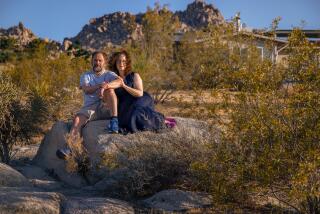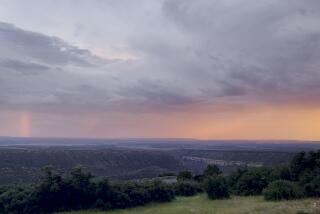A Visit to Egypt’s Great Pyramid With Mummy
- Share via
I happened to mention, in passing, that I had to go to Egypt for a few days, and mother said she thought she might come along as she’d never seen those pointed things and thought it was about time she did.
“The Pyramids?” I suggested.
“Of course the Pyramids,” she said. “I certainly don’t need to see those other pointed things, do I? We’ve got one right here in London, haven’t we? Used to belong to Cleopatra.”
“Obelisks?” I asked.
“You’re so clever” said mother, and started to pack.
I wasn’t sure that this was all that terrific an idea. Looking at Pyramids and obelisks and tombs involves a certain amount of walking, which was something mother found troublesome. Ever since her accident, that is.
She’d been an actress for most of her life until that fateful day when, appearing in a production of “The Curse of the Werewolf” at the Basingstoke Repertory Theater she’d fallen off the plaster mountain and broken her hip. I pointed out that a game leg might slow down her sightseeing a bit but she brushed me aside.
“I can always sit down,” she said. “I’m sure they have places in Egypt where you can sit down.”
They do. One of them is the Hilton Hotel in Cairo. I like Hilton Hotels. Little slices of America all over the world; you know what you’re going to get for your money. The faucets deliver the water at the correct temperature, the rooms are clean and comfortable and you can get a hamburger whenever you want one. Mother thought it was pretty nice, too.
I found her in the American Express office in the hotel lobby. She was telling the pretty Egyptian girl behind the counter all about Egypt.
“And the Pyramids, you know, are 2,000 years old.”
The girl smiled politely.
“Five thousand, in fact,” she said.
“Are you sure?” asked mother, in the tone of one who has serious doubts about the comprehensiveness of the Egyptian educational system.
I pushed myself forward.
“Five, mother. At least five.”
Mother beamed. She knew where I’d been to school.
“You’re so clever,” she said, then turned to the girl. “Well, we’d like to see them, please. And anything else of interest.”
The girl smiled. “There’s the Sphinx.”
“That’ll do nicely,” said mother.
The bus was very smart. It had “American Express” painted on the side. Mother, with some dramatic flourishes of her cane, negotiated the steps and we settled into the front seat. The front seat was a mistake. In fact, any seat was a mistake.
Cairo traffic moves very fast. Very fast indeed. A determined lawlessness rules the road. Stop signs are there to be ignored. If you dare to come to a halt at a red light, the drivers caught behind you will, as one man did, lean on their horns and shout rude things at you.
This, for a nervous visitor, is unsettling. The authorities obviously have tried to contain this antisocial behavior by placing a policeman at each intersection. These poor men seem unsure of their duties but fill the time by smiling graciously into the middle distance while making small, meaningless gestures at the traffic thundering by.
“Aren’t we going fast?” said mother. “And why have you got your eyes shut?”
After a while the noise of the city faded behind us. The bus stopped lurching back and forth and settled down to a steady 80 m.p.h., allowing me to regain sufficient courage to open my eyes and take a peek out of the window.
In the distance the Pyramids loomed. Not many things in this life loom, but the Pyramids do. Their size almost defies description. Forget the Sears building or the Empire State or any proposed edifice from the office of Donald Trump. There’s not a structure in the world that can touch them for sheer monumental grandeur. We are talking big .
Standing in the shadow of King Khufu’s ego, your eye is incapable of encompassing the whole. You can’t see the summit, you can’t determine where the corners turn--in fact, all you can really make out are the vast, two-ton-and-up blocks of ocher stone that terrace up like a giant’s staircase.
“I’m not climbing up that ,” said mother.
I pointed out the sign that told us, in 12 languages, including English, that she wasn’t allowed to anyway.
“Thank God for that,” she said. “Now I think I ought to sit down somewhere.”
Hoisting mother onto one of the lowest of the two-ton stones was more than I could handle, so we looked around for something smaller on which she could perch.
Fifty feet away, across scorching, broken ground, was a man with a camel. He was grinning encouragingly in our direction.
“I could sit on that,” said mother.
We picked our way over what remains of King Khufu’s personal cemetery. Close up, the camel looked bigger than he had from 50 feet away and not nearly as friendly as his owner.
Noting our apprehension, the man tugged on the halter. The camel groaned, buckled its knees and settled slowly onto its stomach. Mother shook her head.
“I don’t think I want to sit on it after all,” she said.
“Is OK. Quite safe. He very nice,” said the man.
“Oh,” said mother. “Well, then, perhaps I could just lean up against it?”
She limped over to the camel and cautiously leaned against its flank. The camel muttered under its breath.
“On top?” suggested the man.
“No, thank you very much,” said mother.
“OK,” said the man. “Maybe you too old for on top.” He turned to me. “Now you take photo.”
I took a photograph of mother with the man and the camel and then suggested that, if she felt comfortable enough where she was, I would leave her for a quarter of an hour to visit Khufu’s burial chamber deep in the heart of the Great Pyramid.
She said that she felt reasonably comfortable staying with the man and the camel and, besides, she had her cane if there was going to be any trouble, so not to worry, she would be just fine. I started to walk away.
“Hey!” shouted the man. “You pay! You pay for photo! And take old lady with you.” He gestured proudly at his camel. “He not for leaning on. He is Photo Opportunity!”
I gave the man enough money to buy several more Photo Opportunities, found a medium-size rock for mother to sit on and left her in the blistering sunshine staring at the Sphinx’s backside.
A large, fierce-looking Egyptian stood by the entrance to the Pyramid. He shuffled forward as I approached and a beefy arm blocked my passage.
“I am Guide,” he announced.
“Thank you,” I said. “But, look, I don’t really need a guide. I’m just going in and then coming out. If you see what I mean?”
“OK,” said Guide. “I guide in, I guide out. No problem.”
I followed Guide through the twisted, broken entrance and into the hot gloom of the Great Pyramid. A stone ramp, covered with slatted planks, led up at a steep angle. Guide, coughing and spitting like a bronchial sea lion, started up the incline. I followed.
The ceiling was low. I was bent almost double, but my head still brushed the stonework above me. And the ceiling, unlike the rest of the passage, is stained a shiny black. It took me a few minutes to work out why; the stones have been brushed for decades by countless heads. The discoloration is caused by hair oil, ancient and modern.
The interior of the Great Pyramid is not a place for claustrophobics. The structure has stood for more than 5,000 years, but the sense of all those tons of rock, fitted together by the fallible hand of man and now hanging mortar-less over your head can play unpleasant games with your imagination.
I got a feeling of relief when, halfway up, the corridor widened and the ceiling soared up. Perhaps, after all, the thing wouldn’t fall on my head. Shortly after that, breathing heavily, you reach the burial chamber of King Khufu.
Guide was very informative.
“Walls,” he announced. “Also, floor and roof. Burial chamber of King. Very interesting.”
I nodded. It was, in a dull sort of way.
Guide pointed to the only object in the room. “Red stone sarcophagus. Empty now. King not in it.”
I looked at the red stone sarcophagus. Guide was right. No sign of King. A gum wrapper and a crushed Coca Cola can, but no King. It seemed an awfully long way to come just to look at a bare stone room and a red horse trough.
The treasures the chamber once held are long gone, stolen by the tomb robbers of the time. They would probably have taken the granite sarcophagus, too, if only they could have lifted it.
Even back then a Catch-22 principle was in operation. Khufu and other Pharaohs like him built these vast structures to their greater glory, riddling them with intricate security systems to preserve their bodies and their treasures intact from marauders.
But all the marauders saw, looking across the desert at these great, glistening things, were billboards shrieking the message: “Come and get it!” And get it they did, proving forever that no matter how big and strong you build your safe, there’s always going to be some guy, somewhere, who can crack it.
I found mother sitting on her rock.
“All right?” I asked.
“Rather hot,” she said. “And I’ve seen quite enough of the Sphinx, thank you very much. At least from this angle.”
The girl behind the counter back in the American Express office thought perhaps we might like to take a trip down the Nile to see the Valley of the Kings.
“Are there any Pyramids there?” asked mother.
“No. No Pyramids. Many tombs. Many statues. No Pyramids.”
“Ah,” said mother. “Perhaps another time. After the Pyramids, anything else would probably be an anticlimax.”
“Not to mention the Sphinx,” I said.
“Please don’t,” said mother.
More to Read
Sign up for The Wild
We’ll help you find the best places to hike, bike and run, as well as the perfect silent spots for meditation and yoga.
You may occasionally receive promotional content from the Los Angeles Times.






